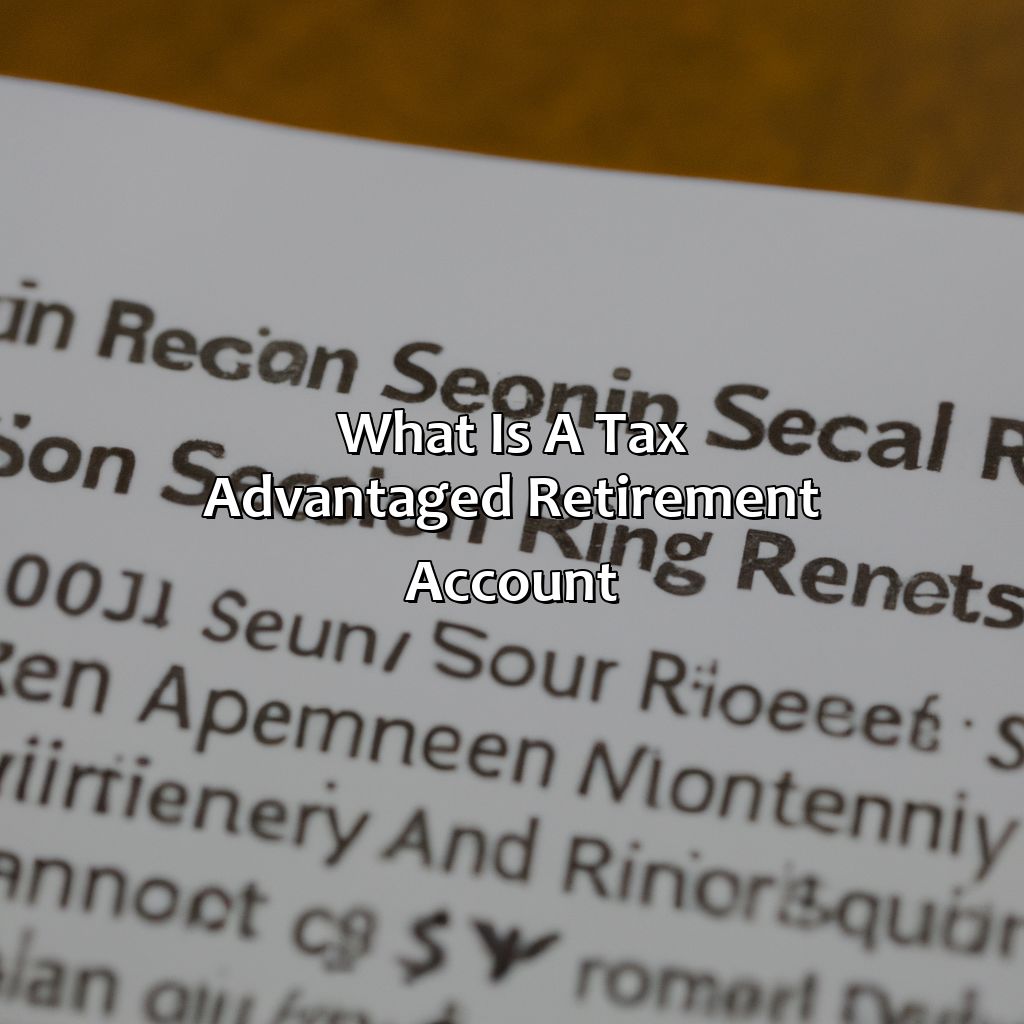What Is A Tax Advantaged Retirement Account?
Key Takeaway:
- A tax advantaged retirement account is a savings plan specifically designed to help individuals save for retirement while providing various tax benefits.
- There are several types of tax advantaged retirement accounts, including Traditional IRAs, Roth IRAs, 401(k)s, 403(b)s, Simplified Employee Pension (SEP) IRAs, and Savings Incentive Match Plan for Employees (SIMPLE) IRAs. Each account has different tax implications and contribution limits.
- The benefits of tax advantaged retirement accounts include tax deferral, compounding interest, lower tax rates in retirement, and required minimum distributions (RMDs). These accounts allow individuals to grow and protect their savings for retirement.
Do you worry about where to invest your savings for retirement? Look no further! Tax advantaged retirement accounts are one of the smartest investments you can make to secure your future. You’ll want to learn more about how they work and how to get started.
Definition of tax advantaged retirement account
A tax-advantaged retirement account is an investment account that has special tax benefits, intended to encourage individuals to save for retirement. These accounts include 401(k)s, IRAs, and Roth IRAs. Contributions to these accounts are generally tax-deductible, and earnings grow tax-free until withdrawn during retirement. Withdrawals are taxed at the individual’s tax rate at the time of withdrawal. Overall, tax-advantaged retirement accounts offer a valuable way to save money for retirement while minimizing taxes.
In addition to tax benefits, some retirement accounts offer other advantages, such as employer contributions or the ability to invest in specific funds. For example, a 401(k) may offer matching contributions from an employer, while a Roth IRA allows for tax-free withdrawals in retirement. Each type of account has different rules and benefits, so it’s important to understand the specifics of each account before investing.
It’s important to note that while these accounts offer tax benefits, there are strict withdrawal rules and penalties for withdrawing funds before reaching retirement age. Additionally, there are annual contribution limits for each type of account, which vary based on age and income.
According to Forbes, “IRAs offer workers and their spouses a tax break for setting aside money for retirement,” making them a popular choice for retirement savings.
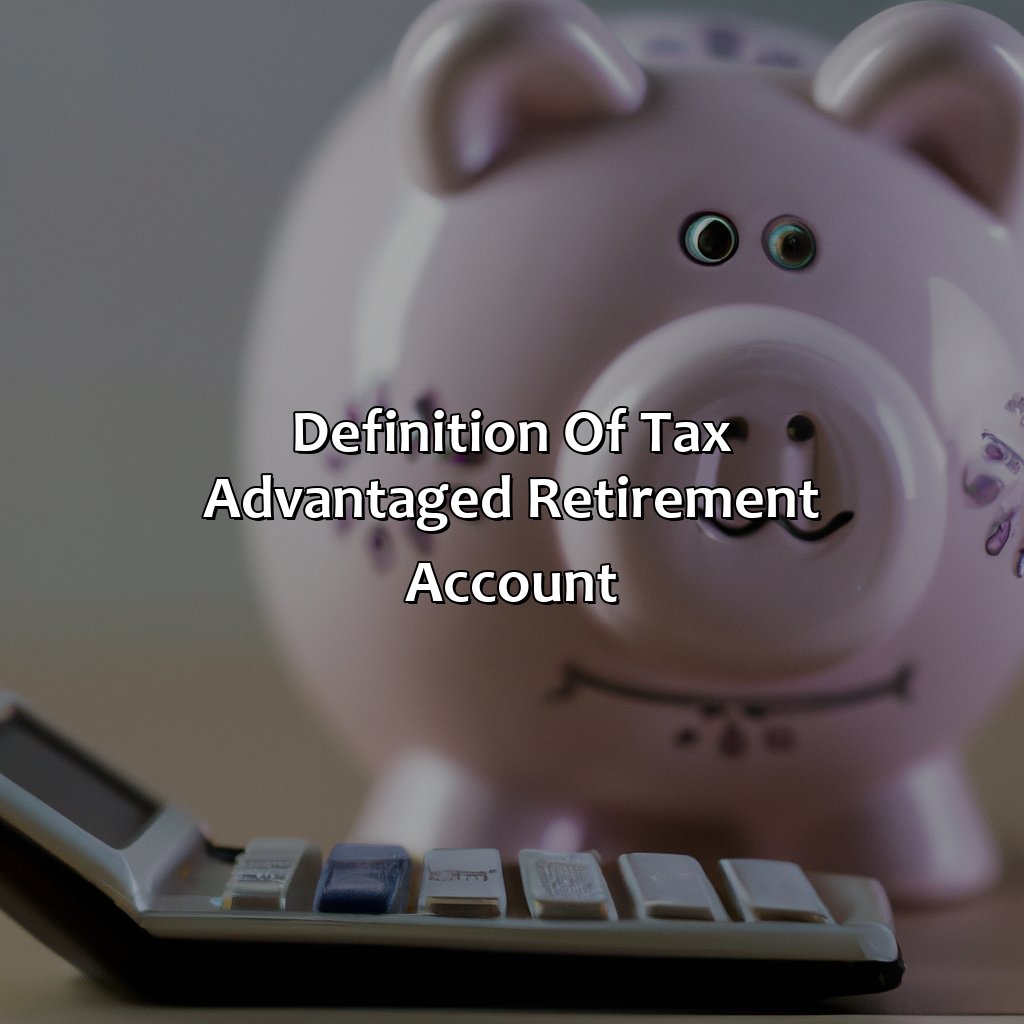
Image credits: retiregenz.com by James Washington
Types of tax advantaged retirement accounts
Investigate “Types of tax advantaged retirement accounts”! Traditional IRA, Roth IRA, 401(k), 403(b), Simplified Employee Pension (SEP) IRA, and Savings Incentive Match Plan for Employees (SIMPLE) IRA are your guides. Uncover the special features and advantages of each one. Then, pick the correct tactic for your financial future.
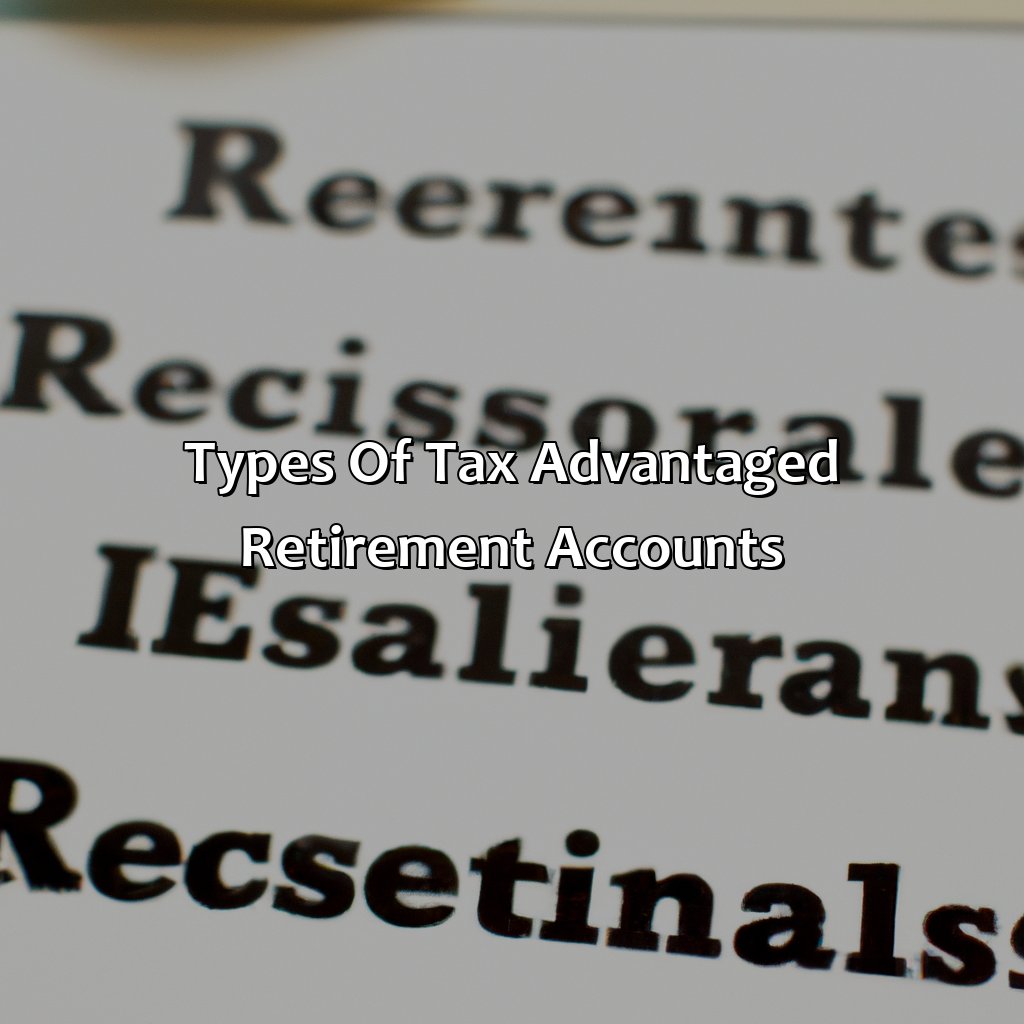
Image credits: retiregenz.com by Joel Jones
Traditional IRA
A commonly used tax-advantaged retirement account, the IRA allows individuals to contribute a portion of their income on a pre-tax basis, reducing current taxable income. Contributions and earnings grow tax-free until withdrawal during retirement years. Contributions typically have tax implications during withdrawal, but individuals may be in a lower tax bracket post-retirement.
One significant benefit of IRAs is their flexibility; they come in various forms such as Roth IRAs, Simple IRA’s, and SEP IRA’s that cater to specific needs. Still, each type has unique contribution limits and withdrawal rules. Individuals can fund their accounts with stocks, mutual funds, and other investments.
Notably, traditional IRAs have required minimum distributions (RMDs) for account holders who reach the age of 72 or older. RMDs ensure that caretakers receive taxes due on these contributions even after passing away. In some cases, individuals may be exempt from this requirement.
Pro Tip: Consider speaking with a financial advisor or tax professional before opening an account or making substantial contributions to an IRA as there are limitations based on factors like age and income level that could impact eligibility for certain types of accounts.
Saving for retirement with a Roth IRA is like investing in a vampire – it’s all about avoiding sunlight (taxes) and hoping for immortality (financial security).
Roth IRA
A tax-advantaged retirement account that allows individuals to contribute after-tax dollars and withdraw qualified distributions tax-free is a type of investment account known as a Roth Individual Retirement Account or Roth IRA. The significant benefit of this type of account is that it offers both flexibility and security for retirement savings.
Unlike traditional IRAs, which provide the option of a tax deduction on contributions made, Roth IRAs offer tax-free withdrawals during retirement. Additionally, there are no age-based Required Minimum Distributions (RMDs) associated with Roth IRAs, making them suitable for individuals who wish to hold onto their retirement savings longer.
Furthermore, another unique feature of a Roth IRA is that it allows for contributions at any age, with no restriction on earned income levels. This makes it an excellent option for older individuals who still have taxable income but want to make up for lost time in saving for their retirement.
A study conducted by the Investment Company Institute revealed that the total amount contributed to Roth IRAs increased from $75 billion in 2010 to $133 billion in 2019, demonstrating the growing popularity and usefulness of this particular type of tax-advantaged account.
Why retire on a beach when you can retire with a yacht? That’s the beauty of a 401(k) plan – investing in your future while dreaming big in the present.
401(k)
Popular tax-advantaged retirement accounts for US employees include plans like the employer-sponsored defined contribution plan, colloquially known as a deferred compensation plan. These plans are designed to provide a means for individuals to save funds toward their retirement years without paying taxes on that income immediately.
So what is the 401(k) plan? Similar to a deferred compensation plan, it is an employer-sponsored option designed to encourage employees to save funds for retirement by providing financial incentives such as employer-matching contributions. Unlike traditional pensions, which promise fixed benefit payments upon retirement, 401(k)s offer more control over investment risks and earnings potential.
It’s worth noting that there are two types of 401(k) offerings. The first is a traditional account where contributions come out of pre-tax payroll dollars and your earnings grow tax-free until withdrawal in retirement; taxes are only paid when distributions commence. The second option is known as a Roth account 401(k), where contributions come from after-tax payroll dollars however earnings and withdrawals are not subject to federal taxes.
Did you know that roughly one-third of Americans have nothing saved towards their retirements, according to the US Federal Reserve?
Retire in style with a 403(b) – because nothing says luxury like tax advantages and compound interest.
403(b)
A 403(b) is a tax advantaged retirement plan available to employees of certain non-profit organizations, including public schools and universities.
With a 403(b), employees can contribute pre-tax income towards their retirement savings, reducing their taxable income for the year. Contributions to a 403(b) are limited by annual contribution limits set by the IRS. In addition, some employers may offer matching contributions up to a certain percentage of the employee’s salary.
Withdrawals from a 403(b) are generally taxed at the employee’s ordinary income tax rate, but if taken after age 59 and a half and with at least five years of participation in the plan, withdrawals are penalty-free.
Consider taking advantage of your employer’s 403(b) plan as part of your retirement planning strategy. Don’t miss out on potential tax advantages and employer contributions that can help you build your retirement savings.
Saving for retirement with a SEP IRA? More like ‘SEP-tic tank’ because your money is fermenting until you reach 59 1/2.
Simplified Employee Pension (SEP) IRA
A retirement saver’s dream is the Simplified Employee Pension. This variation of an Individual Retirement Account or IRA caters to small business owners who do not want cumbersome retirement plans. In simpler terms, it allows employers to make contributions on behalf of their employees towards retirement savings.
The SEP IRA plan was established by employers for their employees, with both parties allowing contributions based on the employer’s profits. It is easy to establish and maintain and has low administration fee costs, and allows tax-deductible contributions up to 25% of an employee’s salary or $58,000 (whichever is a lower figure). One significant feature that stands out with SEP IRAs is self-employed individuals and sole proprietorships also qualify for it.
Unlike most other employer-sponsored plans which require some form of matching contribution, the employer bears all funding responsibilities of the SEP IRA plan. A retired heart surgeon wished he had started his financial planning earlier and opted to go with a SEP IRA when he began his surgical practice in his early thirties. He made consistent contributions through payroll deduction for over three decades. The retiree beams at the substantial amount he had saved by the time he retired in his sixties with financial stability and freedom as one of his biggest assets.
Why settle for a complicated retirement plan when you can SIMPLY IRA your way to financial security?
Savings Incentive Match Plan for Employees (SIMPLE) IRA
The SIMPLE IRA is a retirement plan that benefits employees of small businesses with up to 100 employees. This type of retirement account allows employees to make contributions from their paycheck and offers employers the choice of making matching contributions. The goal is to encourage savings for retirement and provide a tax-advantaged benefit that helps retain employees.
One unique feature of the SIMPLE IRA is that it has lower contribution limits compared to other types of retirement accounts, making it more accessible for smaller businesses. Additionally, this type of account can be set up easily without requiring too much paperwork or administrative costs.
Historically, the SIMPLE IRA was introduced into law by Congress as part of the Small Business Job Protection Act in 1996. In recent years, many small business owners have relied on this type of account to help their employees save for retirement while also receiving tax benefits.
Saving for retirement is like playing a game of chess, but with tax advantaged retirement accounts, you get to move your pieces twice as fast.
Benefits of tax advantaged retirement accounts
Reap the perks of tax advantaged retirement accounts! Enjoy tax deferral and the chance to gain compound interest. This could lead to lower tax rates during retirement, so more money for you. Don’t forget RMDs though; this is vital to avoiding penalties.
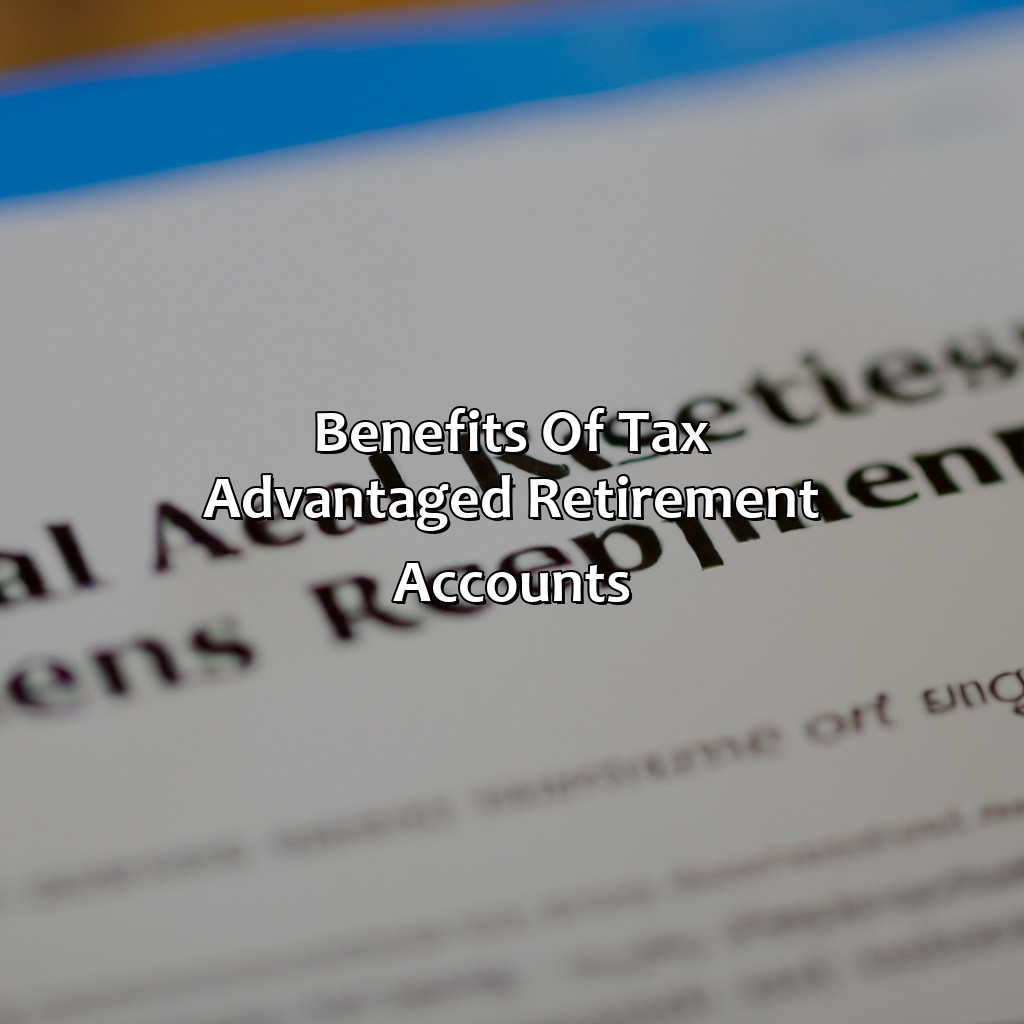
Image credits: retiregenz.com by Yuval Washington
Tax deferral
The process of postponing the payment of taxes is known as tax deferral. Tax-deferred retirement accounts are set up to allow individuals to contribute funds towards their retirement and to reduce taxes at the same time. These accounts receive preferential tax treatment, allowing individuals to pay taxes on their investment earnings later when they withdraw their funds during retirement.
These types of accounts include 401(k)s, individual retirement accounts (IRAs), and 403(b) plans, which offer a vast range of investment options that enable account holders to invest in stocks, bonds, mutual funds, among others. Contributions made by an individual in these accounts are not taxed until they are withdrawn during retirement.
By deferring taxes on retirements savings now, account holders get to benefit from compounding growth for several years before paying any income tax on the gains. This can lead to a significant increase in wealth over time especially if the investments produce above-average returns.
In recent studies by Fidelity Investments, people who had used IRAs and other tax-advantaged retirement accounts saved more than twice as much as those who did not use them.
Source: Fidelity Investments study
Compound interest – the eighth wonder of the world. Just like my ex, it keeps growing and growing without any effort on my part.
Potential to earn compound interest
Investing in a tax-advantaged retirement account can generate a favorable outcome. Such plans have potential for compound interest and are suitable for individuals looking to save money for their future. Every penny compounds yearly, leading to greater savings at maturity.
To maximize the potential of earning compound interest, it is critical to start contributing early. Regular contributions ensure that the account balance grows consistently over time, despite any market downturns. Depending on the type of plan, dividends and capital gains can also be reinvested, resulting in significant long-term profits.
Moreover, tax-advantaged retirement accounts protect earnings from taxes until withdrawal during the retirement years when living expenses and tax rates may change positively. Traditional 401(k), IRA investments offer immediate relief against income taxes of vesting amounts to build substantial growth and more.
It is a Fact that the compound interest feature of retirement accounts works best when contributions occur over several years. As per Forbes magazine, investing $5,000 annually starting from age 25 at an annual return rate of 8 percent will result in savings worth nearly $600K by age 65.
Finally, a time when being old pays off: lower tax rates in retirement.
Lower tax rates in retirement
One of the most significant advantages of having a tax-advantaged retirement account is the potential for lower tax rates in retirement. This means that the taxes you pay on your withdrawals from these accounts during retirement can be significantly lower than what you would have paid if you had used a regular taxable account. By deferring your taxes until later and letting your investments grow, you can potentially reduce your overall tax burden in retirement.
With traditional 401(k) and IRA accounts, contributions are typically made with pre-tax dollars, which means that they are deducted from your taxable income for the year. This reduces the amount of income subject to taxes each year and could potentially put you in a lower tax bracket. Furthermore, contributions to Roth 401(k) and IRA accounts are made with post-tax dollars, meaning that you pay taxes on them upfront. However, once invested, both principal and earnings may be withdrawn tax-free after age 59½.
It’s important to note that every individual’s situation is unique when discussing tax implications. For example, some retirees may have additional sources of taxable income or investments outside of their retirement accounts. As such it’s important to work with a financial advisor who understands your specific circumstances to ensure that you’re optimizing your retirement plan for maximum tax advantage.
Interestingly, back in 1921 when life insurance companies were proposing their first pension plan they came up with the concept of “retirement income,” based on actuarial tables that showed how long people were likely to live after retirement if they made it there at all. Over time, this has developed into modern-day individual policies and various types of annuities and pensions – particularly since Uncle Sam created incentives for saving through qualified plans over half a century ago in order to manage corporate liability for retired employees.
RMDs: When the IRS starts knocking on your retirement account’s door, you better be ready with a big enough candy jar.
Required minimum distributions (RMDs)
When you have a tax-advantaged retirement account, you will eventually need to make Required Minimum Distributions (RMDs), which are withdrawals that the IRS requires you to take after reaching a certain age. These RMDs are based on your account balance and life expectancy, and they vary for different types of accounts.
It’s essential to calculate your RMD correctly to avoid penalties. If you withdraw less than the required amount, then the IRS will penalize you with a 50% tax on the difference between what you withdrew and what you should have withdrawn. However, if you withdraw more than needed, then it can cause other financial problems like an increase in your tax rate due to additional income.
Moreover, RMDs can affect investment strategies. You may want to adjust your investment choices as the age limit approaches so that your money is available when you need it.
One example of how RMDs impact individuals is regarding their beneficiaries’ inherited IRA accounts. The beneficiaries must follow their own respective deadlines for taking distributions from an inherited IRA account and each has a separate distribution schedule based on his or her age and life expectancy as mandated by IRS rules. In some cases, if there is a delay in beginning the distributions following the death of the original owner, it may result in penalties from the IRS.
The RMD rules can be complex, but understanding them is critical for planning purposes so that one stays compliant with federal regulations and avoids damaging financial effects.
Saving for retirement is like playing a game of chess, but with tax advantaged retirement accounts, you’ve already got your opponent in checkmate.
Examples of tax advantaged retirement account strategies
Investigate retirement account strategies with tax benefits! Planning for RMDs, Maximizing Contributions, and Converting from Traditional to Roth IRA all have distinct advantages. Make smart decisions about your retirement plan by knowing these subsections.
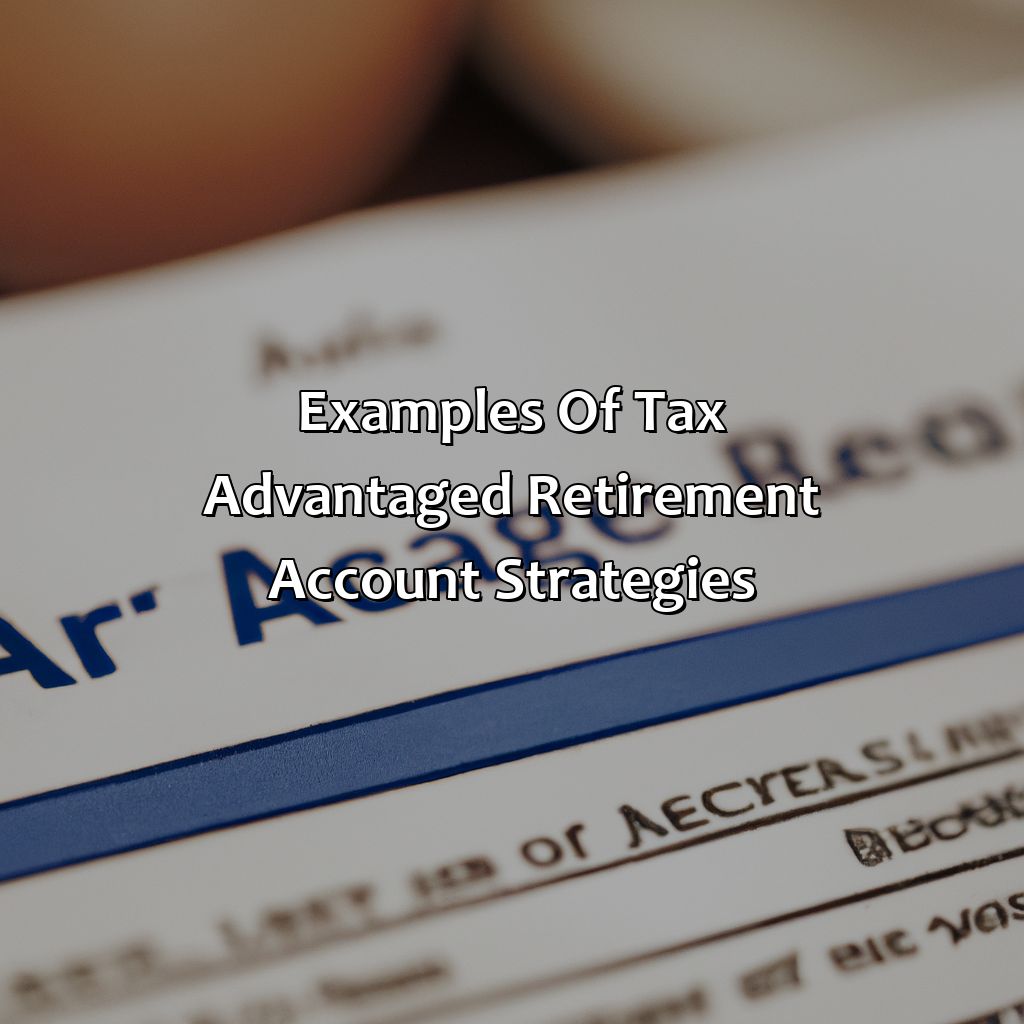
Image credits: retiregenz.com by Harry Jones
Planning for RMDs
Preparing for Required Minimum Distributions (RMDs) from retirement accounts is crucial to avoid penalties. Understanding the nuances of tax laws and planning ahead can lead to better financial outcomes in one’s post-retirement years.
One approach to managing RMDs could be maximizing contributions to IRA accounts and converting traditional IRA funds to a Roth IRA over time, lowering taxable income when withdrawals begin.
Another strategy could be utilizing qualified charitable distributions (QCDs) from Individual Retirement Arrangements (IRAs). QCDs allow individuals aged 70 and a half and older to direct up to $100,000 annually from their IRAs tax-free to qualified charities, satisfying RMD requirements while reducing taxable income.
Additionally, an assessment of overall retirement portfolio allocations should consider blend of taxable and tax-advantaged accounts across stocks, bonds, real estate investment trusts (REITs), exchange-traded funds (ETFs), etc.
Lastly, staying up-to-date on changing regulations or newly available tax-advantaged strategies is key. Consulting with a certified financial planner or accredited wealth advisor may provide unique insights tailored for individual retirement needs and goals. Don’t miss out on what could have been done today as it can impact your future years surprisingly.
Saving for retirement is like playing a game of chess, and maximizing contributions is your queen – put her in the right place and you’ll be in checkmate come retirement.
Strategies for maximizing contributions
To optimize retirement savings, here are some approaches for increasing contributions to a tax-favored retirement account:
- Max out contributions annually.
- Contribute where it is matched by employers.
- Catch-up contributions when over 50 years of age.
- Inquire about special features such as Roth vs Traditional accounts.
Moreover, taking advantage of these strategies can foster a comfortable future after a long working career. Aiming to save as much as possible while also benefiting from tax-deductible contributions and employer-matching funds will alleviate financial concerns when retirement finally arrives.
During Linda’s last decade before retiring at the mandatory retirement age, she maximized her contributions every year and was able to enjoy her spared money tax-free when it counted most. She managed to allocate further resources in an individual investment account, providing even more financial security in the future beyond the benefits from the federal pension plan alone.
Converting from a traditional IRA to a Roth IRA is like trading in your old sweater for a brand new, much more stylish one, but without the guilt of spending too much money.
Converting from a traditional IRA to a Roth IRA
One possible literal meaning of the heading ‘Converting from a traditional IRA to a Roth IRA‘ could be ‘Transforming a Traditional IRA into a Roth IRA‘. When considering retirement account strategies, this conversion can be beneficial in certain situations. By doing so, you’ll pay taxes on contributions at current rates while accumulating tax-free earnings, unlike the traditional IRA.
This transformation is best for those expecting low-income years to come or who have time before retirement for compounding returns. It’s worth noting that converting will require paying income taxes on the amount you switch over. Taxes vary based on each individual’s situation and are due in the year of conversion.
It’s important to check with experts since you may want to tweak your usual withholding rates as we move past 2020 and its specific tax codes/relief measures. Such efforts are well worth talking about, though.
Recently, a lady converted her Traditional IRA portfolio into a Roth version during last year’s low-market days. She avoided future regulations by paying slightly elevated taxes now because current market conditions decreased her account value temporarily.
I may not have a retirement plan, but at least I have enough wine to drown my financial sorrows.
Key considerations when selecting a tax advantaged retirement account
Stop searching! Here’s the perfect tax-advantaged retirement account for your financial journey. Consider age and retirement goals, income level, tax brackets, investment options, fees, and expenses. In this article, let’s discuss these sub-sections to help you find the best retirement plan.

Image credits: retiregenz.com by Adam Washington
Age and retirement goals
Retirement planning must entail a significant consideration of one’s age and retirement objectives. It is crucial to account for these aspects while selecting a tax-deferred retirement account.
The selection of an appropriate tax-advantaged retirement account varies depending on individuals’ unique factors like current income, risk tolerance, and time horizon until retirement. One must identify their expected income level in retirement so that they can determine the most suitable option. An individual’s projected expense and expenditure also need further focus as it gives insights into what percentage of the retirement corpus will be required for sustenance purposes versus discretionary expenditures.
It is vital to make an informed decision since there are limitations on contribution amounts tied to each plan. The right strategy can efficiently increase long-term benefits.
According to Reuters’ report, 54% of Americans have saved less than $25,000 for retirement, emphasizing the significance of making smart investment choices earlier rather than later in life.
Choose your retirement account wisely, because living off social security and cat food doesn’t sound too appetizing, no matter how frisky your feline friend is.
Income level
Considering your earnings status before selecting a retirement account is critical. Your income level should dictate which tax-advantaged retirement account best suits you. While some accounts like Roth IRAs are accessible to high earners, traditional IRAs incentivize lower-income groups.
Additionally, an individual’s employment stability can also contribute to which retirement account best benefits them. If you plan on working for a company that offers a 401(k) match, contributing the maximum amount could be financially advantageous.
Understanding the rules and penalties surrounding each type of retirement plan is crucial to long-term financial stability. A lack of proper planning regarding required minimum distribution age or contribution limits could end up costing more in penalties than anticipated.
Ultimately, leaving money on the table by not maximizing contributions to a retirement account can limit future independence and create undue stress in later years – act now for long-term financial success.
Remember, the only thing certain in life are death, taxes, and trying to decipher which tax bracket you fall into.
Tax brackets
Taxable Income Brackets are a significant aspect of the US Tax Code. It is the range of incomes that fall under a specific tax rate, and it differs based on the individual’s filing status, like single, married filing jointly or separately, or head of household.
The table below shows the 2021 tax brackets for Single filers with taxable income:
| Rate | Taxable Income Range |
|---|---|
| 10% | $0 – $9,950 |
| 12% | $9,951 – $40,525 |
| 22% | $40,526 – $86,375 |
| 24% | $86,376 – $164,925 |
| 32% | $164,926 – $209,425 |
| 35% | $209,426 – $523,600 |
| 37% | >$523,601 |
To ensure you maximize your retirement savings and minimize your taxes paid in later years, it is crucial to consider contributing to a retirement account where contributions can be deducted from your current taxable income. Retirement accounts such as traditional IRAs and 401(k) plans offer an immediate tax break but incur taxes on withdrawal at retirement age.
Pro Tip: Using Tax-Advantaged Retirement accounts will save you thousands of dollars on taxes over time when used wisely. Why settle for a boring old savings account when you can invest in stocks and take your retirement account to the moon?
Investment options
When it comes to choosing a tax-advantaged retirement account, investment opportunities are a crucial consideration. These accounts provide various investment options ensuring flexibility and diversity in your portfolio.
Some tax-advantaged retirement accounts offer limited investment options such as target-date funds or mutual funds, while others like self-directed IRA provides more freedom to invest in stocks, real estate, and even precious metals.
It’s essential to understand each account’s investment options as they have different risks and returns associated with them. This understanding can help you make informed decisions about which account is right for you.
Considering the range of investment options in a tax-advantaged retirement account can ensure success in your retirement savings strategy. Don’t miss out on the chance to strengthen your future financial wellbeing by not researching the various investment choices available to you.
Retirement accounts should come with a warning label: ‘May contain hidden fees and expenses, causing sudden onset of financial regret.’
Fees and expenses
Expenses and Charges:
One crucial aspect to consider before selecting an appropriate tax advantaged retirement account is the expenses and charges associated with it. Understanding these expenses will help you make an informed decision about your long-term savings plan.
- The cost structure of each type of account differs significantly, so it is important to evaluate them before investing.
- Consider the account management fees, transfer or rollover charges, custodian fees, as well as any penalties for early withdrawal.
- You should also take into consideration any additional costs for maintaining a low balance or inactivity fees.
- Ensure that you understand all of the various charge structures associated with the account thoroughly before making your investment decision.
- Finally, keep in mind that high fees can erode your earnings over time and negatively impact your retirement savings goal.
When evaluating different tax advantaged retirement accounts based on their various fees and expenses, you should also consider other factors such as contribution limits and investment options. Therefore, it is important to analyze all aspects before choosing the right one.
Did you know that some financial advisors advise clients to stay away from high-fee mutual funds when their expense ratio exceeds 1%? These costs can seem negligible individually but could add up significantly over time resulting in reduced retirement savings.
Five Facts About Tax Advantaged Retirement Accounts:
- ✅ Tax advantaged retirement accounts are savings vehicles designed to provide tax benefits to help people save for retirement. (Source: Investopedia)
- ✅ Examples of tax advantaged retirement accounts include 401(k), Traditional IRA, and Roth IRA. (Source: NerdWallet)
- ✅ Contributions to tax advantaged retirement accounts are typically tax deductible, meaning they reduce a person’s taxable income for that year. (Source: IRS)
- ✅ Withdrawals from tax advantaged retirement accounts are taxed differently based on the type of account and its specified tax treatment. (Source: Fidelity Investments)
- ✅ Tax advantaged retirement accounts often have contribution limits and other restrictions, and it’s important to understand these when planning for retirement savings. (Source: The Balance)
FAQs about What Is A Tax Advantaged Retirement Account?
What is a tax advantaged retirement account?
A tax advantaged retirement account is a type of savings account designed for retirement that offers tax benefits to individuals. These accounts generally include 401(k)s, traditional IRAs, and Roth IRAs.
What are the tax benefits of a tax advantaged retirement account?
The specific tax benefits vary depending on the account, but generally these accounts offer tax-deferred growth, tax-deductible contributions (for traditional IRAs and 401(k)s) or tax-free distributions in retirement (for Roth IRAs).
Who is eligible for a tax advantaged retirement account?
Most individuals who earn income are eligible to open and contribute to a tax advantaged retirement account. However, there are income limitations and contribution limits for certain accounts such as Roth IRAs and Traditional IRAs.
When should I start contributing to a tax advantaged retirement account?
The earlier you start contributing to a tax advantaged retirement account, the better. Time is a crucial factor in retirement savings because it allows your investments to grow and compound over time. The earlier you start, the more time you have to save and invest.
What happens if I need to withdraw money from my tax advantaged retirement account before retirement?
If you withdraw money from a tax advantaged retirement account before retirement, you may be subject to taxes and penalties. Depending on the account and the reason for the withdrawal, you may also be required to pay back any tax benefits you received.
Can I have more than one type of tax advantaged retirement account?
Yes, you can have more than one type of tax advantaged retirement account. For example, you may have a 401(k) through your employer and also contribute to a Traditional IRA on your own. However, contribution limits still apply to each account type.
